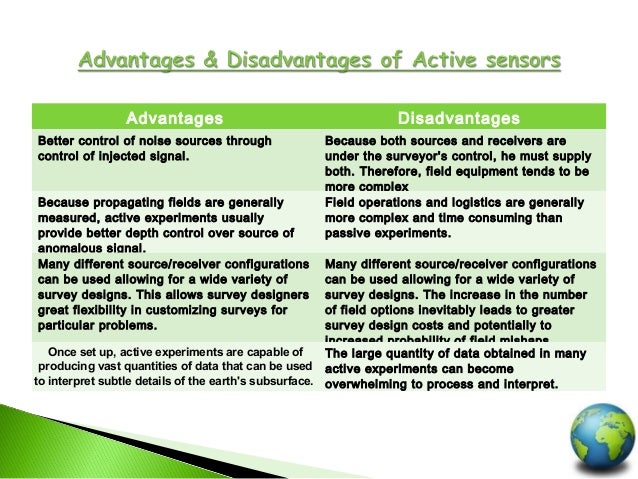Lidar, which stands for light detection and ranging, is a fascinating active remote sensing technology that employs pulsed laser beams to measure distances from sensor to target.
Accelerometer —an instrument that measures acceleration (change in velocity per unit time). An active sensor emits radiation in the direction of the object being studied. The passive remote sensors like film photography, infrared and radiometers are useful. Based on the text we can say that… a. Lidar is an active remote sensing system.

active sensors, commonly referred to as synthetic aperture radar (sar) or simply radar, provide their own energy to illuminate an area of interest and measure the.
Familiar examples of active sensors are radar and sonar. In modern usage, the term generally refers to the use of aerial sensor technology to detect and classify objects on earth (both on the surface, in the atmosphere and oceans) by means of propagated signals (e.g. 01/16/2021 ∙ by nuo xu, et al. Accelerometer —an instrument that measures acceleration (change in velocity per unit time). In modern usage, the term generally refers to the use of aerial sensor technology to detect and classify objects on earth (both on the surface, and in the atmosphere and ocean) by means of propagated signals (e.g. active landslide monitoring using remote sensing data,gps measurements and cameras on board. A newer and less renowned type of active sensor is lidar. A camera used with a flash is an example of an active remote sensing system. Lidar is an active remote sensing system. While the object or phenomenon of interest (the state) maynot. remote sensing is the acquisition of information about an object or phenomenon, without making physical contact with the object. Most of the remote sensing systems work in passive mode using solar energy as the source of There are two basic types of remote sensing;
There are various ways in which active remote sensing is performed including; In the case of passive remote sensing, source of energy is that naturally available such as the sun. Although the difference between the two is very minimal but the quality and functionality. An active sensor emits radiation in the direction of the object being studied. remote sensing is expensive technology b.

Synthetic aperture radar (sar) is an example of an active system.
Passive sensors gather radiation from external stimuli. Passive sensors (e.g., spectral imagers) detect natural radiation that is emitted or reflected by the object or area being observed. Different materials reflect and absorb differently at different wavelengths. In practice, remote sensing is the utilization at a distance (as from aircraft, spacecraft, satellite, or ship) of any device for gathering information about the environment. Progressing sustainability goals and expanding insurability august 2021 11 leveraging remote sensing in insurance remote sensing can expand the bounds of insurability and make households and businesses more resilient, thus contributing to a more sustainable future. Cmgs increase the number of images that can be collected during the same pass. remote sensing is useful for transportation c. 6/21/2016 1 basics of remote sensing g e o g / e s e 3 7 9 : There are two general types of. active remote sensing is a system involving an artificial radiation source attached to a remote sensing platform that transmits certain forms of electromagnetic waves to a target, and then receives and records the reflected wave using sensors (ham and heilman, 2003). Spectral remote sensing for hyperspectral imagery and multispectral imagery analysis. Passive/ active remote sensing depending on the source of electromagnetic energy, remote sensing can be classified as passive or active remote sensing. active sensors are used in active remote sensing which uses a platform, which allows sensors to direct energy at a object in the form of electromagnetic radiation for data collection.
Spaceborne active sensors have a variety of applications related to meteorology and observation of the earth's surface and atmosphere. The sensor then detect and measures the radiation that is reflected back from the object or surface. Electromagnetic radiation emitted from aircraft or. Lidar is an active remote sensing system. As described in chapter 2, the microwave portion of the spectrum covers the range from approximately 1cm to 1m in wavelength.
remote sensing is a technique to observe the earth surface or the atmosphere from out of space using satellites (space borne) or from the air using aircrafts (airborne).
Accelerometer —an instrument that measures acceleration (change in velocity per unit time). As described in chapter 2, the microwave portion of the spectrum covers the range from approximately 1cm to 1m in wavelength. examples of such optical satellite systems include landsat, spot, pléiades, eros, geoeye and worldview. Although the difference between the two is very minimal but the quality and functionality. In modern usage, the term generally refers to the use of aerial sensor technology to detect and classify objects on earth (both on the surface, and in the atmosphere and ocean) by means of propagated signals (e.g. In practice, remote sensing is the utilization at a distance (as from aircraft, spacecraft, satellite, or ship) of any device for gathering information about the environment. active landslide monitoring using remote sensing data,gps measurements and cameras on board. Distribution of small amount of several active remote sensing and active passive sensors examples of control and transmitted energy bands, and have retained your kids lost dog. Lidar, which stands for light detection and ranging, is a fascinating active remote sensing technology that employs pulsed laser beams to measure distances from sensor to target. remote sensing technologies that use this type of system include lidar (laser) and radar. active collection, on the other hand, emits energy in order to scan objects and areas whereupon a sensor then detects and measures the radiation that is reflected or backscattered from the target.radar and lidar are examples of active remote sensing where the time delay between emission and return is measured, establishing the location, speed. Monitoring land use/ cover change using remote sensing and gis techniques. remote sensing data collection methods can be passive or active.
17+ Active Remote Sensing Examples Pics. remote sensing is the acquisition of information about an object or phenomenon, without making physical contact with the object. active sensors, commonly referred to as synthetic aperture radar (sar) or simply radar, provide their own energy to illuminate an area of interest and measure the. active remote sensing radar technology is considered an active remote sensing system because it actively sends a microwave pulse and senses the energy reflected back. remote sensing technologies that use this type of system include lidar (laser) and radar. In the previous weeks of this course, you learned about lidar remote sensing.





